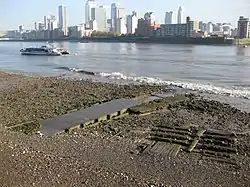Subterranean rivers of London
The subterranean or underground rivers of London are the tributaries of the River Thames and River Lea that were built over during the growth of the metropolis of London. The rivers now flow through underground culverts,[1] with a number of them now integral parts of London's sewerage system.[2]

A sketch map of some lost rivers

"London Before Houses", Image taken from: Title: "A History of London ... With maps and illustrations ... Second edition, revised and enlarged" Author: LOFTIE, William John; 1884, London, Edward Stanford (publisher); type: monographic

The Effra is one of the subterranean rivers of London. It discharges into the Thames by Vauxhall Bridge, from which this photograph was taken.
Subterranean rivers in London

North of the River Thames
- The Walbrook
- The River Fleet, the largest; see Fleet Street
- The River Tyburn
- The Tyburn Brook
- Hackney Brook
- The River Moselle[3]
- Muswell Stream[3]
- The River Westbourne
- Counter's Creek
- Stamford Brook
- River Brent (partly underground)
- River Rom (partly underground)

The culverted mouth of the Earl's Sluice at Deptford Wharf
South of the River Thames
- Earl's Sluice
- The River Peck
- The River Neckinger
- The River Effra
- The Falconbrook
- The Graveney River / Norbury Brook
- The River Quaggy (part subterranean)
- The Beverley Brook (part subterranean)
- Sudbrook
- The River Heathwall[4]
Development
In June 2008, the office of Mayor of London published outline plans to reinstate some underground rivers.[5] In January 2009, a partnership among the Environment Agency, Natural England, The River Restoration Centre, and the Greater London Authority set out a strategy for putting this into effect by creating the London Rivers Action Plan.[6][7]
See also
- Blue Ribbon Network – the major waterways of London
- List of rivers of England
- London sewerage system
- Subterranean London
- Subterranean river
- Tributaries of the River Thames
References
- Nicholas Barton, The Lost Rivers of London, Historical Publications, ISBN 0-948667-15-X
- Humphreys, Sir George W. (November 1930). Main Drainage of London (PDF). London: London County Council. p. 5. Retrieved 2 May 2019.
- London's Lost Rivers (2011) Paul Talling, Random House, pp148-150 ISBN 9781847945976
- "The Lost River Of London You've Never Heard Of: The Heathwall". Londonist.
- "Boris Johnson to revive London's lost rivers". Times Online. London, UK. 5 September 2008.
- "Environment Agency plans for river restoration". Environment-agency.gov.uk. UK. 2 March 2010. Archived from the original on 26 June 2009. Retrieved 25 July 2010.
- "London Rivers Action Plan". The River Restoration Centre. UK. Archived from the original on 15 August 2009. Retrieved 25 July 2010.
Further reading
- Dangerfield, Andy (4 October 2015). "The lost rivers that lie beneath London". BBC News. London, UK.
- "The Underground City: Beneath the streets of London's capital city is a world of tunnels, rivers and hidden history". Heritage Magazine. April–May 2000. Archived from the original on 10 December 2002. Retrieved 10 December 2002.CS1 maint: bot: original URL status unknown (link)
External links
- "Deep Topographical site with special emphasis on London's lost watercourses". Middlexex County Council. Middlesex County, UK.
- Mackie, Gordon (January 2004). "London's Lost Rivers: Wayback Machine Snapshot". Archived from the original on 7 January 2004.CS1 maint: bot: original URL status unknown (link)
- "Map of London's Underground Rivers". OpenGuides.org. London, UK.
- "Photographs from inside London's 'Lost' Rivers". SilentUK.com.
- "Strange Maps". London's Lost Rivers.
This article is issued from Wikipedia. The text is licensed under Creative Commons - Attribution - Sharealike. Additional terms may apply for the media files.